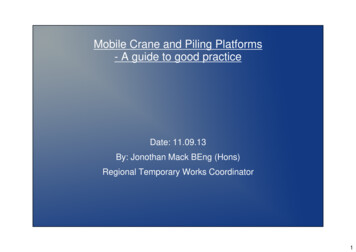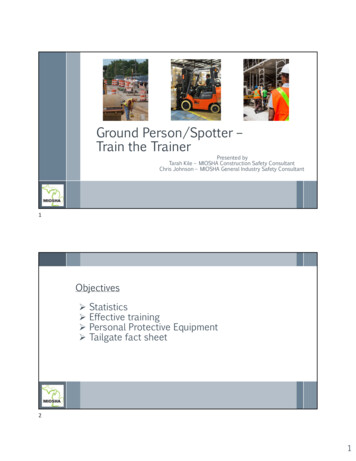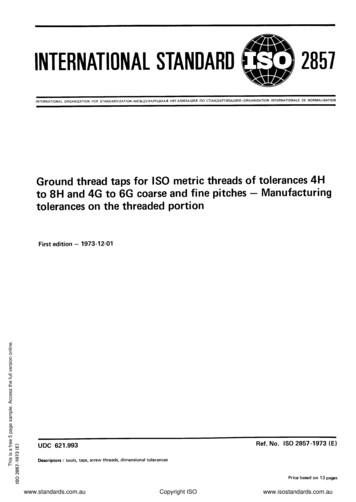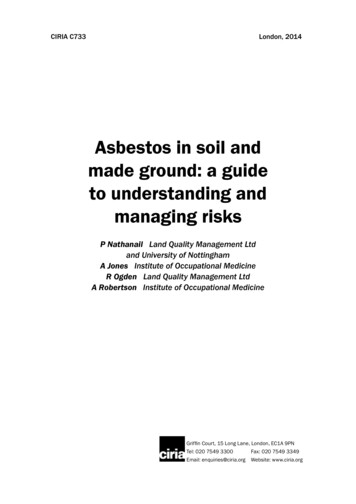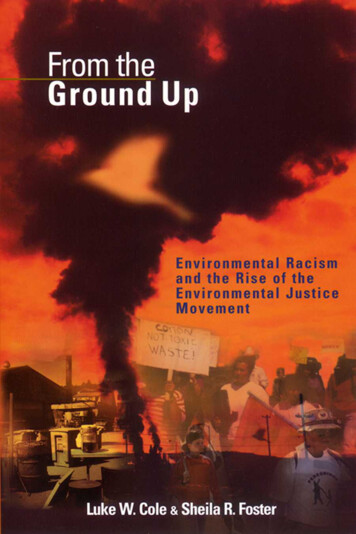
Transcription
From the Ground Up
CRITICAL AMERICAGeneral Editors: RICHARD DELGADO and JEAN STEFANCICWhite by Law: The Legal Construction of RaceIan F. Haney LópezCultivating Intelligence: Power, Law, andthe Politics of TeachingLouise Harmon and Deborah W. PostPrivilege Revealed: How Invisible PreferenceUndermines AmericaStephanie M. Wildman with Margalynne Armstrong,Adrienne D. Davis, and Trina GrilloDoes the Law Morally Bind the Poor? or What Good’s the ConstitutionWhen You Can’t Afford a Loaf of Bread?R. George WrightHybrid: Bisexuals, Multiracials, and Other Misfitsunder American LawRuth ColkerCritical Race Feminism: A ReaderEdited by Adrien Katherine WingImmigrants Out! The New Nativism and the Anti-ImmigrantImpulse in the United StatesEdited by Juan F. PereaTaxing AmericaEdited by Karen B. Brown and Mary Louise FellowsNotes of a Racial Caste Baby: Color Blindness andthe End of Affirmative ActionBryan K. FairPlease Don’t Wish Me a Merry Christmas: A Critical History ofthe Separation of Church and StateStephen M. Feldman
To Be an American: Cultural Pluralism andthe Rhetoric of AssimilationBill Ong HingNegrophobia and Reasonable Racism: The Hidden Costs ofBeing Black in AmericaJody David ArmourBlack and Brown in America: The Case for CooperationBill PiattBlack Rage Confronts the LawPaul HarrisSelling Words: Free Speech in a Commercial CultureR. George WrightThe Color of Crime: Racial Hoaxes, White Fear, Black Protectionism, Police Harassment, and Other MacroaggressionsKatheryn K. RussellThe Smart Culture: Society, Intelligence, and LawRobert L. Hayman, Jr.Was Blind, But Now I See: White Race Consciousness and the LawBarbara J. FlaggThe Gender Line: Men, Women, and the LawNancy LevitHeretics in the Temple: Americans Who Reject the Nation’s Legal FaithDavid Ray PapkeThe Empire Strikes Back: Outsiders and the Struggleover Legal EducationArthur AustinInterracial Justice: Conflict and Reconciliation inPost–Civil Rights AmericaEric K. YamamotoBlack Men on Race, Gender, and Sexuality: A Critical ReaderEdited by Devon Carbado
When Sorry Isn’t Enough: The Controversy over Apologies andReparations for Human InjusticeEdited by Roy L. BrooksDisoriented: Asian Americans, Law, and the Nation StateRobert S. ChangRape and the Culture of the CourtroomAndrew E. TaslitzThe Passions of LawEdited by Susan A. BandesGlobal Critical Race Feminism: An International ReaderEdited by Adrien Katherine WingLaw and Religion: Critical EssaysEdited by Stephen M. FeldmanChanging Race: Latinos, the Census, and the History of EthnicityClara E. RodríguezFrom the Ground Up: Environmental Racism and the Rise ofthe Environmental Justice MovementLuke W. Cole and Sheila R. Foster
Luke W. Cole andSheila R. FosterFROM THEGROUND UPENVIRONMENTAL RACISMAND THE RISE OF THEENVIRONMENTALJUSTICE MOVEMENTaNew York University PressNew York and London
NEW YORK UNIVERSITY PRESSNew York and LondonCopyright 2001 by New York UniversityAll rights reservedLibrary of Congress Cataloging-in-Publication DataCole, Luke W., 1962–From the ground up : environmental racism and the rise of theenvironmental justice movement / Luke W. Cole and Sheila R. Foster.p. cm. — (Critical America)Includes bibliographical references and index.ISBN 0-8147-1537-0 (pbk.) — ISBN 0-8147-1536-2 (cloth)1. Environmental justice—United States. 2. Environmentalpolicy—United States. 3. Minorities—United States—Politicalactivity. I. Foster, Sheila R., 1963– II. Title. III. Series.GE180 .C65 2001363.7'0089'00973—dc2100-010595New York University Press books are printed on acid-free paper,and their binding materials are chosen for strength and durability.Manufactured in the United States of America10 9 8 7 6 5 4 3 2 1
For Ralph Santiago AbascalL U K E W. C O L EFor My FamilySHEILA R. FOSTER
CONTENTSAcknowledgmentsxiPreface: We Speak for Ourselves: The Struggleof Kettleman City 1Introduction10ONEA History of the Environmental Justice Movement19TWOThe Political Economy of Environmental Racism: Chester ResidentsConcerned for Quality of Life 34THREEEnvironmental Racism: Beyond the Distributive Paradigm54FOURButtonwillow: Resistance and Disillusion in Rural California80FIVEProcesses of Struggle: Grassroots Resistance and the Structure ofEnvironmental Decision Making 103SIXIn Defense of Mother Earth: The IndigenousEnvironmental Network 134SEVENTransformative PoliticsAppendix151167Notes185Index231About the Authors ix 244
ACKNOWLEDGMENTSThis book is the product of the work and input of many people over thepast six years. We particularly thank Maricela Alatorre, Bineshi Albert,Bradley Angel, Jerome Balter, Francisco Beltran, Lydia Beltran, ArnoldCohen, Joseph Della Fave, Juanita Fernandez, Lorenzo Garcia, TomGoldtooth, June Kruszewski, Mary Lou Mares, Lupe Martinez, Esperanza Maya, Joe Maya, Zulene Mayfield, Dora Montoya, Eduardo Montoya, Saul Moreno, Sylvia Moreno, Dennis Palla, Juan Reyes, RosaSolorio-Garcia, Tiwana M. Steward-Griffin, and Jackie Warledo for theirhelp in the case studies found in the Preface and chapters 2, 4, 6, and 7,and for teaching us about environmental justice. Judith Lurie andMiriam Montesinos conducted field interviews for chapter 4; Henry Komansky provided invaluable research for chapter 2 and parts of chapter7; Jen Gadbow and Sergio Garza helped transcribe interviews. RalphAbascal, Skip Cole, Giovanna Di Chiro, Michel Gelobter, Nancy Shelby,and Katie Silberman provided insightful feedback and editorial advice.Charles Lee, himself a one-person history of the Environmental JusticeMovement, has been an invaluable colleague and source of information.Dana Alston, Carl Anthony, Robert Bullard, Deeohn Ferris, Tom Goldtooth, Vernice Miller, and Richard Moore have all provided importantdirection both to the Movement and to us at various stages of our thinking about environmental justice. Our editors, Richard Delgado and JeanStefancic, have been unwavering in their support of this project duringits long gestation period. Rutgers University School of Law-Camdenalso provided crucial support, both tangible and intangible, toward thecompletion of this book.Parts of this book were adapted from the following previously published articles: Luke W. Cole, The Theory and Reality of CommunityBased Environmental Decision-Making: The Failure of California’s Tanner Act and its Implications for Environmental Justice, 25 Ecology LawQuarterly 733 (1999); Luke W. Cole, Environmental Justice and the xi
AcknowledgmentsThree Great Myths of White Americana, 3 Hastings West-NorthwestJournal 449 (1996); Luke W. Cole, Macho Law Brains, Public Citizens,and Grassroots Activists: Three Models of Environmental Advocacy, 14Virginia Environmental Law Journal 687 (1995); Luke W. Cole,Civil Rights, Environmental Justice and the EPA: The Brief History of Administrative Complaints under Title VI, 9 Journal of EnvironmentalLaw and Litigation 309 (1994); Luke W. Cole, Environmental JusticeLitigation: Another Stone in David’s Sling, 21 Fordham Urban LawJournal 523 (1994); Luke W. Cole, The Struggle of Kettleman City forEnvironmental Justice: Lessons for the Movement, 5 Maryland Journal ofContemporary Legal Issues 67 (1994); Luke W. Cole, Empowermentas the Key to Environmental Protection: The Need for EnvironmentalPoverty Law, 19 Ecology Law Quarterly 619 (1992); Luke W. Cole,Remedies for Environmental Racism: A View from the Field, 90 Michigan Law Review 1991 (1992); Sheila Foster, Justice from the GroundUp: Distributive Inequities, Grassroots Resistance, and the TransformativePolitics of the Environmental Justice Movement, 86 California LawReview 775 (1998); and Sheila Foster, Impact Assesment and PublicParticipation in The Law of Environmental Justice: Theories andProcedures to Address Disproportionate Risks (Michael B. Gerrard,ed., 1999). xii
PREFACEWe Speak for OurselvesThe Struggle of Kettleman CityEl pueblo unido jamas sera vencido (“The people united shallnever be defeated”)—Chant and slogan from the farm-worker justice movementStories are one way we transmit our history, share our successes, andlearn from our losses. Stories are also an important part of the movementfor environmental justice, which has as one of its central tenets the idea“We speak for ourselves.” This book tells the stories of ordinary men andwomen thrust into extraordinary roles as community leaders, grassrootsexperts, and national policymakers. We invoke these stories to illustratethe human reality behind the numerous studies that chart the disproportionate distribution of environmental hazards, and the burgeoninggrassroots movement for environmental justice that has sprung uparound the country.The first story is about Kettleman City, one of the defining strugglesof the early days of the Environmental Justice Movement. The story is aclassic David-and-Goliath tale, in which a small farm-worker town tookon the largest toxic waste dumping company in the world—and won.Kettleman City is a tiny farm-worker community of 1,100 residents inKings County, in California’s San Joaquin Valley.1 Ninety-five percent ofKettleman residents are Latino, 70 percent of the residents speak Spanish at home, and roughly 40 percent are monolingual Spanish speakers.They are primarily farm-workers who work in the fields that spread outin three directions from Kettleman City. Kettleman City is much likemany other rural communities in the Southwest, and few people wouldknow about it were it not for the fact that Kettleman City is also host to 1
Prefacethe largest toxic waste dump west of Alabama, a landfill that is ownedand run by Chemical Waste Management, Inc, about three and a halfmiles from town, hidden behind some low hills. The dump was createdin the late 1970s without the community’s knowledge or consent.People marvel that a gigantic toxic waste site can be placed just milesfrom a community without the community’s knowledge. In California,under state environmental laws, government agencies are required toprovide public notice in three ways: (1) through notices printed in anewspaper of general circulation, which in Kettleman City means a smallbox in the classified ads in the Hanford Sentinel, published forty milesaway; (2) by posting signs on and off the site, which means on a fencepost three and a half miles from Kettleman City; and (3) by sending notices through the mail to adjacent landowners.2 The adjacent landowners to the Chem Waste facility are large agribusiness and oil companiessuch as Chevron.Residents of Kettleman City found out about the dump in the early1980s, after reading in the local paper about multimillion-dollar fineslevied against the Chem Waste facility for violations of environmentallaws. While residents were unhappy to find out their town was host to ahuge toxic waste facility, they saw few ways in which they could challengethe dump.Things changed in 1988, when Chem Waste proposed to build a toxicwaste incinerator at the dump site. Residents in Kettleman City heardabout this proposal not from Chem Waste, not from Kings County orstate officials, but from a phone call from a Greenpeace organizer in SanFrancisco. Bradley Angel, Southwest campaigner for Greenpeace’s toxics campaign, had received a phone call from the Kings County sheriffone afternoon in January 1988, asking him whether Greenpeace plannedto demonstrate at the hearing in Kettleman City that night. After finding out about the hearing, Angel called one of the few people he knewin Kettleman City at the time, Esperanza Maya, and said, “Espy, did youknow that there’s a hearing tonight in your community about a toxicwaste incinerator?” She said, “I haven’t heard a thing about it.”Maya grabbed a few of her neighbors and went to the hearing. Theywere shocked to find out that Chem Waste was proposing to build anincinerator that would burn up to 108,000 tons—216,000,000pounds—of toxic waste every year. That translates to about 5,000 2
Prefacetruckloads of toxic waste that would pass through the Kettleman areaeach year, in addition to the hundreds of daily truckloads bound forthe existing toxic dump.After the hearing, many Kettleman City residents began to do theirhomework about the dump, the incinerator, and the company, Chemical Waste Management. They formed a community group, El Pueblopara el Aire y Agua Limpio (People for Clean Air and Water). The groupfound out that the air in the San Joaquin Valley was already contaminated, that the Valley is considered the second-worst polluted air basinin the United States, ranking behind only Los Angeles. And, whereas LosAngeles has ocean breezes to cleanse it, the San Joaquin Valley, becauseof its unique bathtub shape, is a closed system, so pollutants stay put andfill the Valley.Members of El Pueblo also found out about a 1984 report done forthe California Waste Management Board. That report, known popularlyas the Cerrell Report, and paid for California taxpayers’ dollars, suggested to companies and localities that were seeking to site garbage incinerators that the communities that would offer the least resistance tosuch incinerators were rural communities, poor communities, communities whose residents had low educational levels, communities that werehighly Catholic, communities with fewer than 25,000 residents, andcommunities whose residents were employed in resource-extractive jobslike mining, timber, or agriculture.3 When members of El Pueblo lookedaround Kettleman City, they were startled. “The Cerell report fit us to aT,” says Mary Lou Mares, one of the leaders of El Pueblo. The incinerator proposal suddenly also made sense to Kettleman residents: “Ifthere’s a report that specifically tells them what to look for, of coursethey’re going to target us,” observes Mares.El Pueblo also looked at California’s other toxic waste dumps. California has three Class I toxic waste dumps—the dumps that can take justabout every toxic substance known to science. The group found out thatin addition to Kettleman (95 percent Latino), the two other dumps werein Buttonwillow, where 63 percent of the residents are people of color,primarily Latino, and in Westmorland, which is 72 percent Latino.4 “Itseemed like a conspiracy,” says Mary Lou Mares, “although it’s logical ifthey are using the Cerrell report.” Both Buttonwillow and Westmorlandlook just like Kettleman: they are small, predominantly Latino, rural 3
Prefacefarm-worker communities marked by high levels of poverty. People inKettleman City began to put two and two together.The PatternThen El Pueblo looked at the company, Chemical Waste Management,the largest toxic waste dumping company in the U.S. Chem Waste runsthe largest toxic waste dump in the country (and, probably, the world)in Emelle, Alabama, which is in the heart of Alabama’s black belt, in acommunity that is about 95 percent African American.5 Emelle actuallylooks a great deal like Kettleman City—small, rural, poverty-stricken—but the residents are black instead of brown.Even more interesting were the locations of Chem Waste’s other incinerators. At the time, Chem Waste owned three other toxic waste incinerators: one on the south side of Chicago in a neighborhood that is55 percent African American and 24 percent Latino;6 one in Port Arthur,Texas, in a community that is about 80 percent black and Latino;7 andone in Sauget, Illinois, which is surrounded by neighborhoods that are95 percent or more African American,8 including East St. Louis, an overwhelmingly African American community that has been called “America’s Soweto.”The residents of Kettleman City started to see a pattern. “Our initialreaction was outrage,” says Maricela Alatorre, a student leader during ElPueblo’s struggle who has lived in Kettleman City her entire life. “Wefelt we were being targeted, that Chem Waste as a corporation was targeting these communities on purpose because their ethnic make-upwould make people least likely to protest.” Every single communitywhere Chem Waste operated its toxic waste incinerators is a communityof color, and substantially so: 79 percent in Chicago and Port Arthur, inthe 90s in Sauget, and 95 percent in Kettleman City. They found outlater that Chem Waste had planned to build an incinerator in Tijuana,Mexico, thereby hitting the 100 percent mark.9The residents of Kettleman City then turned to Chem Waste’s compliance record. At the Kettleman City facility, Chem Waste had beenfined 3.2 million for more than 1,500 incidents of dumping toomuch waste into its evaporation ponds.10 Chem Waste’s incinerator inChicago had blown up and been shut down by the Illinois EPA.11 Illi 4
Prefacenois State Representative Clem Balanoff came to Kettleman City andtold residents about Chem Waste’s overfilling of the Chicago incinerator, which then spewed black smoke plumes, and about the fine ChemWaste faced for having turning off the incinerator’s air monitoringequipment so that nobody would know what was coming out. And itdid so once, not twice, but many times over a period of months.12 InVickery, Ohio, Chem Waste took in PCB-contaminated oil for disposal and then turned around and resold it to a company that used itto repave streets and as fuel oil in nearby communities.13 The residentstook note of Chem Waste’s actions in Louisiana, where the companywas caught storing toxic waste in one of those store-yourself rentallockers.14El Pueblo also discovered that Chem Waste and its parent company,Waste Management, had paid more than 50,000,000 in fines, settlements, and penalties for price fixing, bribery, and related environmentalcrimes. “They could get away with all this because they were a multimillion dollar corporation,” notes Alatorre. “These fines meant nothing tothem.” The company, they found out, was such an environmental badactor that the San Diego District Attorney’s Office had told the SanDiego Board of Supervisors that “the company’s history requires extreme caution by the San Diego County Board of Supervisors or anyother governmental entity contemplating any contractual or business relationship with Waste Management” because of a pattern of continuingcriminal behavior.15Nor was Chem Waste’s behavior ancient history. In the fall of 1992,as the incinerator project was under consideration, Chem Waste wasfined a record 11.5 million for a botched Superfund cleanup in Pennsylvania.16 In Kettleman City, Chem Waste was caught “sample packing.” Ten trucks of waste would show up at the gate of the dump; by lawChem Waste was required to sample each truck to determine its contentsto ensure that incompatible wastes were not disposed of together. WhatChem Waste was doing, however, was taking ten samples from the firsttruck and then waving all the other trucks through.Kettleman City residents felt justified in being a little alarmed by theprospect of having this company run yet another facility near their town.The residents figured that if the company can’t run a hole in the groundcorrectly, it shouldn’t be given the ability to do something worse. 5
PrefaceThe ProcessAs part of the permitting process for the incinerator, Kings County issued an Environmental Impact Report (EIR). The Environmental Impact Report was about 300 pages long, with another 700 pages of appendices, for a total of about 1,000 pages. Kettleman City residents,40 percent monolingual Spanish speakers, 95 percent Latino, said toKings County, “Look, to include us in this decision, you need to translate these documents into Spanish.” Kings County was unresponsive.The County decision makers likely did not want to set a precedent; ifthey translated the EIR, they would have to translate documents inother situations, which is something the people of Kettleman Citythought would probably be a good idea. Chem Waste, in a generousoffer, translated a five-page executive summary and distributed that toevery household in Kettleman City. English speakers in Kings Countythus had about 1,000 pages of data to pore over, while Spanish speakers had five pages.Despite being shut out by the lack of environmental review in theirown language, Kettleman City residents nevertheless attempted to takepart in the process. “We thought if we could get enough people to writeand express their opinion, it would be important,” says El Pueblo leaderMary Lou Mares. Mares and her allies generated almost 120 letters fromthe tiny community, and more than two-thirds of all the comments byindividuals on the EIR were from the people of Kettleman City—inSpanish. Residents wrote in saying, in effect, “Hey, translate this document. Include us in the process. Let us know what you are proposing todo up on the hill. If you say it’s safe, why won’t you let us know whatyou are doing? Why won’t you translate this document?”The public hearing on the incinerator was scheduled not in KettlemanCity but forty miles away, in the county seat of Hanford. It was held inthe largest venue in Kings County, the County Fairground building,which is about the size of a football field. The hearing room was set upwith a raised dais in the front, with a table at which sat the PlanningCommission, looking down on the room. Then there was an open space;beyond that, two microphones set up for the public. Behind the microphones were about fifty rows of seats, and there were some bleacher seatsat the back of the room. Behind the bleachers was empty concrete floor 6
Prefaceback to the very rear of the auditorium, about 300 feet from the Planning Commission.Kettleman City residents showed up at the meeting in force. About200 people came by bus and carpool from Kettleman City, and, as oneof the their leaders made clear, “We’re here, we want to testify on thisproject, and we brought our own translator.” The chair of the KingsCounty Planning Commission looked down on the crowd and said,“That request has been denied. The translation is taking place in the backof the room and it won’t happen up here.”17 Residents looked at wherethe Planning Commissioner was pointing: they looked from the Planning Commission up on their dais, they looked at the open space and themicrophones, they looked at all the rows of chairs, and they looked at thebleachers. And then they looked way back behind the bleachers, nearlyat the rear of the room, where there was one forlorn man sitting surrounded by a little circle of about twenty-five empty chairs. The PlanningCommission chair said again, “Why don’t you go back there? There aremonitors back there. We are all in the same room.” The 200 people fromKettleman City looked around, and they looked at the back of the roomat those twenty-five chairs, and they looked at the empty chairs up front,and they said, “Adelante, adelante” (“forward, forward”), and theymoved up to the front of the room. Residents testified in Spanish, fromthe front of the room, that the last time they had heard about peoplebeing sent to the back of the room was when African Americans weresent to the back of the bus—a policy dumped in the dustbin of history ageneration ago. They said they weren’t going to stand for that.18 “Theincident summed up what the County felt for the people out here in Kettleman City,” notes Maricela Alatorre. “Our rights were second to thishuge corporation.”The public hearing on the project brought to a close the public’s ability to comment on the incinerator. Subsequently, the Planning Commission voted to approve the incinerator, and El Pueblo appealed that decision to the Kings County Board of Supervisors.The Benefits and Burdens of WasteCalifornia has a compensated siting law.19 Under the law, local governments can tax hazardous waste facilities up to 10 percent of their gross 7
Prefacerevenues. What does this have to do with the story? As Kettleman activistMary Lou Mares sums it up, “When it comes to politics, the ones thathave the money win out.”Kings County, which is about 65 percent white, has five members onthe Board of Supervisors. At the time of El Pueblo’s appeal, all the boardmembers were white. Most white residents in Kings County live in onearea, while most of the Latinos live in another part of the County. If thispage were a map of Kings County, almost all the white people would liveup in the upper right corner of the page, in and around the county seatof Hanford. And most of the Latino people would live at the bottom ofthe page—Kettleman City would be in the lower left of the page, and theChem Waste dump would be next to it. Every single town in KingsCounty is majority white except for Kettleman City, which is 95 percentLatino, way down in the lower left of the page. Under the California lawthat provides for compensated siting, Kings County was receiving about 7 million per year in revenue from Chem Waste’s preexisting dump.That 7 million was about 8 percent of the County’s annual budget.20Most of the money is spent up near Hanford (in the upper right of thepage), in the white community, and very little of it trickles down to thepeople of Kettleman City (down in the lower left of the page). The incinerator promised to almost double that tax revenue, so the Countywould be receiving about one-sixth of its annual revenue from this single company. “The County knew people in Hanford didn’t give a damnone way or the other,” points out Joe Maya, a leader of El Pueblo. Notsurprisingly, the white Supervisors voted for the incinerator on a threeto-one vote.The LawsuitFaced with this situation, the residents felt they had no choice but to filea lawsuit. The lawsuit was successful when the judge ruled that the Environmental Impact Report had not sufficiently analyzed the toxic wasteincinerator’s impacts on air quality and on agriculture in the San JoaquinValley and, most importantly, that the residents of Kettleman City hadnot been meaningfully included in the permitting process.21 As theCourt eloquently stated: “The residents of Kettleman City, almost 40percent of whom were monolingual in Spanish, expressed continuous 8
Prefaceand strong interest in participating in the CEQA [California Environmental Quality Act] review process for the incinerator project at [ChemWaste’s] Kettleman Hills Facility, just four miles from their homes. Theirmeaningful involvement in the CEQA review process was effectively precluded by the absence of Spanish translation.”Kings County decided not to appeal the lawsuit, largely because of thepolitical pressure the Kings County Board of Supervisors was receivingfrom Kings County residents and from their supporters across California.A postcard campaign targeting the Board of Supervisors and the localFarm Bureau, orchestrated by El Pueblo and Greenpeace, generatedmore than 5,000 postcards to the Board and the Farm Bureau, while apetition campaign in the San Joaquin Valley by Citizen Action generatedmore than 17,000 signatures in opposition to the incinerator. ChemicalWaste Management did not fold as easily, however, and appealed thejudgment.22 Rather than go back and do the environmental study rightin order to respond to the judge’s (and the residents’) concerns, thecompany was more comfortable staying in court. But Kettleman City’sstruggle had become a national struggle. The residents of KettlemanCity and their representatives were telling Kettleman City’s story atmeetings, conferences, symposia, and rallies across the country. “I thinkthey thought we would go away,” observes Mary Lou Mares, the Kettleman City housewife who appeared on national television to tell theKettleman story. “But it was too dangerous to let an incinerator come inhere—we had to do something about it.” The press loved the story, andsoon people all around the country knew about the struggles of Kettleman City.23The Community Is HeardOn September 7, 1993, Chem Waste announced that it was withdrawing its application to construct the toxic waste incinerator near Kettleman City.24 Although Chem Waste cited changing economic conditionsand a new public policy turn away from incineration,25 the General Manager of the Kettleman Hills Facility personally hand-delivered the newsto one of the leaders of the community group El Pueblo, acknowledgingthe group’s role in the decision.26 As the El Pueblo leader Espy Mayasaid, “I don’t care how they word it; we won.”27 9
INTRODUCTIONEnvironmental hazards are inequitably distributed in the United States,with poor people and people of color bearing a greater share of pollutionthan richer people and white people. This intuitive idea—think for a moment about the most polluted parts of your region—has been borne outby dozens of studies completed over the past two decades.1 The disparateimpact documented in studies has given birth to the term “environmental racism.” When President Clinton signed an Executive Order on Environmental Justice in 1994, the phenomenon of environmental racismgained unprecedented recognition.2 Fueling this recognition is a remarkable rise in grassroots activism communities across the country.Thousands of activists in hundreds of communities are fighting for theirchildren, their communities, their quality of life, their health—and for“environmental justice.”This book is about both the phenomenon of environmental racismand the movement that propelled environmental racism into nationalconsciousness and forced action at the highest levels of government. Theevents and strategies chronicled here ultimately developed out of an alliance of grassroots activists, lawyers, other professionals, and concernedcitizens whose efforts constitute the broad movement for social and economic justice known as the Environmental Justice Movement. Themovement continues to shape environmental policy while creating increased opportunities for marginalized communities to speak out abouttheir own disenfranchisement and the social and economic policies thatsubject them to daily environmental hazards.We approach the subject from both an external and internal perspective. The internal perspective looks at the movement from the “groundup”—from the experience of communities that st
Three Great Myths of White Americana,3 Hastings West-Northwest Journal 449 (1996); Luke W. Cole, Macho Law Brains, Public Citizens, and Grassroots Activists: Three Models of Environmental Advocacy,14 Vi






